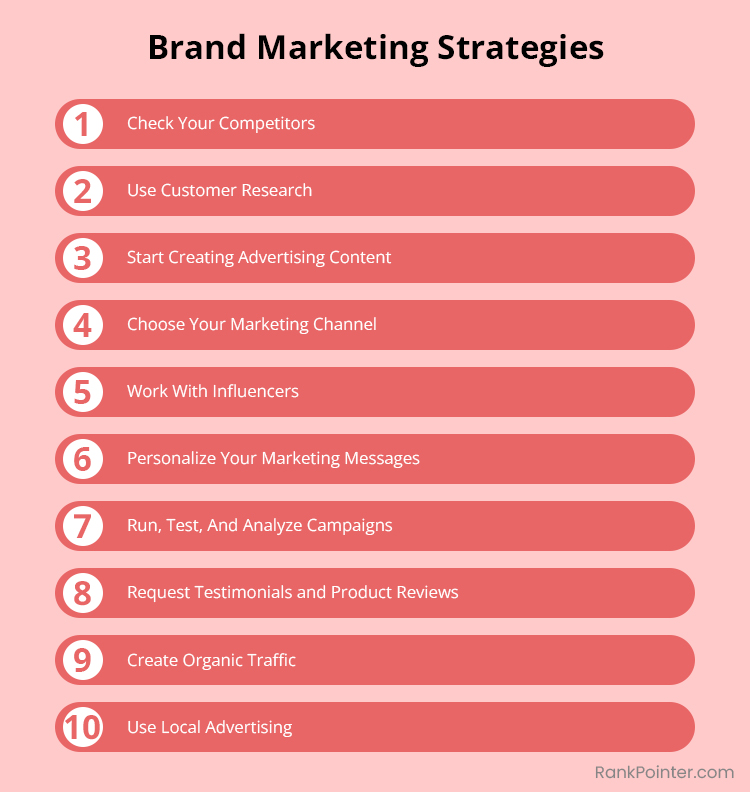Having a great product or service isn’t enough to ensure success in a competitive market. To thrive, businesses must establish a distinctive, trustworthy identity that resonates with consumers and fosters lasting connections. This is where brand advertising plays a pivotal role.
What Is Brand Advertising?
Brand advertising is more than just promoting a product; it’s about cultivating long-term recognition, credibility, and loyalty.
Its primary aim is to establish a deep emotional connection with consumers, compelling them not just to buy a product but to believe in the brand behind it.
Through various mediums like visuals, catchphrases, hashtags, or jingles, brand advertising shapes perceptions, fosters trust, and creates an immediate and favorable response to specific products or companies.
Marketing Strategies for Brands
Check out the effective brand marketing techniques.
1. Check Your Competitors
Understanding competitors’ strategies and market positioning is crucial for crafting effective brand advertising campaigns. Analyzing their promotional channels and tactics helps identify opportunities to differentiate and stand out.
2. Use Customer Research
Creating buyer personas based on thorough research enables brands to tailor content and advertising efforts to resonate with their target audience effectively. Understanding where and how customers engage allows for strategic deployment of resources.
3. Start Creating Advertising Content
Crafting compelling content that speaks directly to the target audience is essential. Aligning messaging, visuals, and design elements with customer preferences helps establish rapport and engagement.
Related Article: Is Your Brand Voice Consistent Across All Platforms?
4. Choose Your Marketing Channel
Identifying the most suitable marketing channels based on customer demographics and behavior ensures efficient allocation of resources. Each channel offers unique advantages and requires tailored strategies.
5. Work with Influencers
Leveraging influencer partnerships can amplify brand reach and credibility, particularly in the realm of social media. Collaborating with influencers allows brands to tap into established audiences and personalize their advertising efforts.
6. Personalize Your Marketing Messages
Tailoring messages to address specific customer needs and desires enhances engagement and resonance. Personalization fosters a deeper connection and increases the likelihood of conversion.
7. Run, Test, And Analyze Campaigns
Continuous monitoring and analysis of brand advertising campaigns are essential for optimization. Testing different strategies and measuring performance against predefined metrics enables iterative improvement and maximizes ROI.
8. Request Testimonials and Product Reviews
Harnessing the power of social proof through testimonials and reviews builds trust and credibility. Positive feedback from satisfied customers reinforces brand reputation and encourages new purchases.
9. Create Organic Traffic
Integrating content marketing and SEO strategies increases organic visibility and attracts relevant traffic. By providing valuable content and optimizing for search engines, brands enhance their online presence and brand authority.
10. Use Local Advertising
Targeting local audiences through local advertising efforts enable brands to connect with communities and drive foot traffic. Leveraging local platforms and channels ensures relevance and resonance within specific geographic markets.

Brand Advertising Examples
Here are some of the examples of brand advertising.
Nike
Nike’s iconic branding combines distinctive visuals, catchy slogans, and celebrity endorsements to create a powerful brand identity that resonates globally.
Adidas
Adidas utilizes creative advertising campaigns and transparent storytelling to build trust and authenticity. By showcasing their manufacturing process, Adidas reinforces its commitment to quality and integrity.
Apple
Apple’s minimalist approach to advertising mirrors the sleek design of its products. Through cohesive branding and innovative storytelling, Apple cultivates a sense of exclusivity and aspiration among consumers.
Conclusion of Brand Advertising
In a crowded marketplace, brand advertising serves as the cornerstone of successful marketing strategies. By leveraging strategic tactics, brands can differentiate themselves, resonate with consumers, and drive long-term loyalty and growth.


